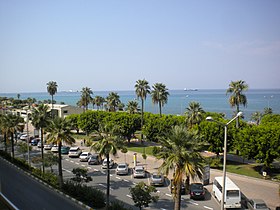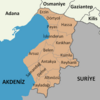İskenderun
| İskenderun | ||||
|
||||
 Promenade on Ataturk Caddesi with a view of the Mediterranean Sea |
||||
| Basic data | ||||
|---|---|---|---|---|
| Province (il) : | Hatay | |||
| Coordinates : | 36 ° 35 ' N , 36 ° 10' E | |||
| Height : | 8 m | |||
| Residents : | 244,970 (2014) | |||
| Telephone code : | (+90) 326 | |||
| Postal code : | 31 xxx | |||
| License plate : | 31 | |||
| Structure and administration (as of 2015) | ||||
| Mayor : | M.Fatih Tosyali ( AKP ) | |||
| Website: | ||||
| İskenderun district | ||||
| Residents : | 244,970 (2014) | |||
| Surface: | 637 km² | |||
| Population density : | 385 inhabitants per km² | |||
| Kaymakam : | H. Hasan Özyiğit | |||
| Website (Kaymakam): | ||||
İskenderun ( Greek Αλεξανδρέττα ; historically Alexandrette or Alexandretta ; Arabic إسكندرون, DMG Iskandarūn ; after Alexander the Great ) is a city in southern Turkey , in the Hatay province at the easternmost tip of the Mediterranean Sea, the Gulf of İskenderun . Since a regional reform in 2014, the district is identical in terms of area and population to the district town.
This city used to be a port for Aleppo in northern Syria. Today it is the trading center of a region where grain , tobacco and citrus fruits are grown . But it is also an important industrial center and the end point of a long oil pipeline from Northern Iraq . In addition, İskenderun is one of the most important Mediterranean ports in Turkey.
history
İskenderun was founded by Alexander the Great (Turkish Büyük İskender ) in 333 BC. Founded as Alexandreia kat'Isson . After defeating Darius III. and Alexander wanted to replace the Persians in the battle of Issus with Myriandros as the key to the Cilician-Syrian gate. İskenderun is about 37 kilometers south of the battlefield at that time.
During the First Crusade , İskenderun was conquered by the Crusaders and incorporated into the Principality of Antioch .
Around 1160 the city was taken by the Armenians , Rainald of Chatillon , the second husband of Constance of Antioch, Prince of Antioch, conquered the city on behalf of Emperor Manuel I (1143–1180) and handed it over to the Templars , who owned the Baghras Castle built to guard the Cilician Gate . After Manuel Rainald refused the promised money, he concluded an alliance with Thoros of Armenia with the approval of the Templars.
From the 16th century İskenderun was part of the Ottoman Empire .
From 1920 to 1938, the Sanjak Alexandrette , the later Turkish province of Hatay, including İskenderun belonged to Syria , which was a French mandate. From September 2, 1938 to August 23, 1939, İskenderun was the capital of the short-lived State of Hatay , which has since been part of Turkey. About 200,000 people live in the city. Various ethnic groups live in the city, including Kurds, Turks, Arabs and Armenians.
sons and daughters of the town
- Zaki al-Arsuzi (1901–1968), Syrian Baathist
- Halil Gülbeyaz (* 1962), writer
- Selçuk İnan (* 1985), soccer player with Galatasaray Istanbul and in the national team
- İsmail Köybaşı (* 1989), football player with Beşiktaş Istanbul and in the national team
- Özgür Özata (* 1977), actor
- Ali Özgür Özdil (* 1969), Islamic scholar and religious educator
- Luigi Padovese OFMCap (1947–2010), Roman Catholic bishop, murdered in İskenderun
- Uğur Şahin (* 1965), immunologist and oncologist
- Sarkis Soghanalian (* 1929, Italy; † 2011), Syrian arms dealer
- Athanasios Toutoungi (1899–1981), Archbishop of Aleppo in Syria
- Fevzi Zemzem (* 1941), former soccer player and coach
Web links
- Immanuel Benzinger : Alexandreia 15 . In: Paulys Realencyclopadie der classischen Antiquity Science (RE). Volume I, 1, Stuttgart 1893, column 1395 f.
Individual evidence
- ↑ a b Turkish Institute for Statistics ( Memento from December 13, 2015 on WebCite ), accessed December 13, 2015
- ↑ Ana Safya. In: company page. İskenderun Demir ve Çelik A.Ş, accessed on April 15, 2018 (Turkish): "Ülkemizin en büyük demir çelik fabrikası İsdemir olarak, (...), German We, İsdemir, as the largest metal manufacturer ..."



